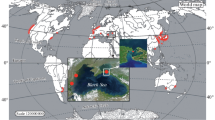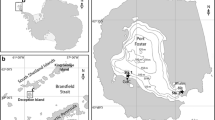Abstract
Tsunamis associated with the 2011 off the Pacific Coast of Tohoku Earthquake seriously disrupted the shallow marine ecosystem along a 2000 km stretch of the Pacific coast of Japan. The effects of the 2011 tsunamis on the soft-bottom benthic community have been relatively well studied in the intertidal zone, whereas tsunami effects on the subtidal benthos remain poorly understood. Here, we investigated populations of the world’s largest spoon worm Ikeda taenioides (Annelida: Echiura: Ikedidae) in subtidal zone of Funakoshi Bay, Tohoku District, northeastern Japan. Subtidal scuba-diving surveys at two sites in the bay showed extremely long proboscises frequently extending from small holes in the sandy seafloor shortly before and soon after the tsunami disturbances. Based on morphological and molecular identification, the proboscises were revealed to be parts of I. taenioides. On 30 November 2011, 265 days after the tsunami event, many large-sized individuals with >1 m long proboscises were observed; these individuals were probably not derived from post-tsunami larval recruitment but more likely survived the tsunami disturbances. This is surprising because other sympatric megabenthos (e.g. spatangoid echinoids and venerid bivalves) and seagrass beds were almost completely destroyed (although they later recovered) by the tsunamis in this bay. The burrows of I. taenioides are known to be very deep (70–90 cm), which may have sheltered them from the impacts of the tsunamis. Our observations suggest that the effects of the 2011 tsunamis on benthos in soft sediments may differ depending on their burrowing depth.








Similar content being viewed by others
References
Aioi K, Komatsu T, Morita K (1998) The world’s longest seagrass, Zostera caulescens from northeastern Japan. Aquat Bot 61:87–93
Anker A, Murina GV, Lira C, Vera Caripe JA, Palmer AR, Jeng MS (2005) Macrofauna associated with echiuran burrows: a review with new observations of the innkeeper worm, Ochetostoma erythrogrammon Leuckart and Rüppel, in Venezuela. Zool Stud 44:157–190
Biodiversity Center of Japan (2013) Annual report on the monitoring site 1000 project: coastal area survey (Rocky Shores, Tidal Flats, Seagrass Beds and Algal Beds). pp 384 (in Japanese with English summary)
Biodiversity Center of Japan (2014) Annual report on the monitoring site 1000 project: coastal area survey (Rocky Shores, Tidal Flats, Seagrass Beds and Algal Beds). pp 466 (in Japanese with English summary)
Biseswar R (2010) Zoogeography of the echiuran fauna of the Indo-West Pacific Ocean (Phylum: Echiura). Zootaxa 2727:21–33
Brito MC, Martínez A, Núñez J (2009) Changes in the stygobiont polychaete community of the Jameos del Agua, Lanzarote, as a result of bioturbation by the echiurid Bonellia viridis. Mar Biodiv 39:183–187
Chavanich S, Siripong A, Sojisuporn P, Menasveta P (2005) Impact of Tsunami on the seafloor and corals in Thailand. Coral Reefs 24:535
Clement M, Posada D, Crandall KA (2000) TCS: a computer program to estimate gene genealogies. Mol Ecol 9:1657–1660
Edmonds SJ (2000) Phylum Echiura. In: Beesley PL, Ross GJB, Glasby CJ (eds) Polychaetes & Allies: The Southern Synthesis. Fauna of Australia. Vol 4A Polychaeta, Myzostomida, Pogonophora, Echiura, Sipuncula. CSIRO Publishing, Melbourne, pp 353–374
Folmer O, Black M, Hoeh W, Lutz R, Vrijenhoek R (1994) DNA primers for amplification of mithondrial cytchrome c oxidase subunit I from diverse matazoan invertebrates. Mol Mar Biol Biotechnol 3:294–297
Goto R, Kato M (2012) Geographic mosaic of mutually exclusive dominance of obligate commensals in symbiotic communities associated with a burrowing echiuran worm. Mar Biol 159:319–330
Goto R, Hamamura Y, Kato M (2011) Morphological and ecological adaptation of Basterotia bivalves (Galeommatoidea: Sportellidae) to symbiotic association with burrowing echiuran worms. Zool Sci 28:225–234
Goto R, Okmaoto T, Ishikawa H, Hamamura Y, Kato M (2013) Molecular phylogeny of echiuran worms (Phylum: Annelida) reveals evolutionary pattern of feeding mode and sexual dimorphism. PLoS One 8:e56809
Hornby RJ (2005) An intertidal spoon worm (Phylum Echiura) in the United Arab Emirates: occurrence, distribution, taxonomy and ecology. Tribulus 15:3–8
Hughes RN, Crisp DJ (1976) A further description of the echiuran Prashadus pirotansis. J Zool Lond 180:233–242
Hughes DJ, Ansell AD, Atkinson RJA (1996) Sediment bioturbation by the echiuran worm Maxmuelleria lankesteri (Herdman) and its consequences for radionuclide dispersal in Irish Sea sediments. J Exp Mar Biol Ecol 195:203–220
Hughes DJ, Atkinson RJA, Ansell AD (1999) The annual cycle of sediment turnover by the echiuran worm Maxmulleria lankesteri (Herdman) in Scottish sea loch. J Exp Mar Biol Ecol 238:209–223
Ikeda I (1901) Real nature of the “Umi-sanada” (“Sanada-yumushi”, new Japanese name). Doubut Zasshi Zool Mag Jpn 13:382–392
Ikeda I (1904) The gephyra of Japan. J Coll Sci Ump Univ Tokyo 20:1–87
Ikeda I (1907) On three new and remarkable species of echiuroids (Bonellia miyajimai, Thalassema taenioides and T. elegans). J Coll Sci Imp Univ Tokyo 21:1–64
Itani G, Izichi M, Ueda H (2005) Crab species collected from the burrows of Urechis unicinctus in Hiuchi-nada, the central Seto Inland Sea. Cancer 14:1–4
Jaramillo E, Dugan JE, Hubbard DM, Melnick D, Manzano M, Duarte C, Campos C, Sanchez R (2012) Ecological implications of extreme events: footprints of the 2010 earthquake along the Chilean coast. PLoS One 7:e35348
Jobb G (2007) TREEFINDER available from Munich. http://www.treefinder.de. Accessed 1 Jan 2015
Jobb G, Haeseler A, Sterimmer K (2004) TREEFINDER: a powerful graphical analysis environment for molecular phylogenetics. BMC Evol Biol 4:18
Jumars PA, Dorgan KM, Lindsay SM (2015) Diet of worms emended: an update of polychaete feeding guilds. Annu Rev Mar Sci 7:20.1–20.4
Kathiresan K, Rajendran N (2005) Coastal mangrove forests mitigated tsunami. Estuar Coast Shelf Sci 65:601–606
Lomovasky BJ, Firstater FN, Salazar AG, Mendo J, Iribrane OO (2011) Macro benthic community assemblage before and after the 2007 tsunami and earthquake at Paracas Bay, Peru. J Sea Res 65:205–212
Maritime Safety Agency (1984) Submarine structural chart, bathymetric chart, report of survey (Kamaisi Wan), basic map of the sea in coastal waters (scale 1:50000), pp 43
McCall PC, Tevesz MJS (1982) The biogenic alternation of sediment. Plenum, New York
Nakaoka M, Tanaka Y, Mukai H, Suzuki T, Aryuthaka C (2006) Tsunami impact on biodiversity of seagrass communities in the Andaman Sea, Thailand: (1) seagrass abundance and diversity. In: Rigby PR, Shirayama Y (eds), Selected Papers of the NaGISA World Congress 2006 pp 49–56
Nishikawa T (2002) Comments on the taxonomic status of Ikeda taenioides (Ikeda, 1904) with some amendments in the classification of the phylum Echiura. Zool Sci 19:1175–1180
Nishikawa T (2012) Ikeda taenioides (Ikeda, 1904). In: Japanese Association of Benthology (ed) Threatened animals of Japanese tidal flats: Red data book of seashore benthos. Tokai University Press, Hatano, p 238
Pemberton GS, Risk MJ, Buckley DE (1976) Supershrimp: deep bioturbation in the Strait of Canso, Nova Scotia. Science 192:790–791
Pilger JF (1980) The annual cycle of oogenesis, spawning and larval settlement of the echiuran Listriolobus pelodes off Southern California. Pac Sci 34:129–142
Reise K (2002) Sediment mediated species interactions in coastal waters. J Sea Res 49:127–141
Ruppert EE, Fox RS, Barners RD (2004) Invertebrate zoology: a functional evolutionary approach, 7th edn. Brooks/Cole-Thompson, Belmont, p 963
Sato H (1931) Report of the biological survey of Mutsu Bay. 20. Echiuroidea. Sci Rep Tohoku Imp Univ 4th Ser Biol 6:171–184
Sato H (1937) Raporto pri la Echiuroidea, Sipunculoidea kaj Priapuloidea en la golfo de Onagawa. Bot Zool Tokyo 5:1855–1859
Sato H (1939) Studies on the Echiuroidea, Sipunculoidea and Priapuloidea of Japan. Sci Rep Tohoku Imp Univ 4th Ser Biol 14:339–460
Seike K, Shirai K, Kogure Y (2013) Disturbance of shallow marine soft-bottom environments and megabenthos assemblages by a huge tsunami induced by the 2011 M9.0 Tohoku-Oki Earthquake. PLoS One 8:e65417
Seike K, Kitahashi T, Noguchi T (2016) Sedimentary features of Onagawa Bay, northeastern Japan after the 2011 M9.0 Tohoku-Oki Earthquake: sediment mixing by recolonized benthic animals decreases the preservation potential of tsunami deposits. J Oceanogr 72:141–149
Stephen AC, Edmonds SJ (1972) The phyla Sipuncula and Echiura. Trustees of the British Museum (Nat. Hist.), London
Stull JK, Haydock CI, Montagne DE (1986) Effects of Listriolobus pelodes (Echiura) on coastal shelf benthic communities and sediments modified by a major California wastewater discharge. Estuar Coast Shelf Sci 22:1–17
Suer AL (1984) Growth and spawning of Urechis caupo (Echiura) in Bodega Harbor, California. Mar Biol 78:275–284
Volkenborn N, Hedtkamp SIC, Van Beusekom JEE, Reise K (2007) Effects of bioturbation and bioirrigation by lugworms Arenicola marina on physical and chemical sediment properties and implications for intertidal habitat succession. Estuar Coast Shelf Sci 74:331–343
Whanpetch N, Nakaoka M, Mukai H, Suzuki T, Nojima S, Kawai T, Ayuthaka C (2010) Temporal changes in benthic communities of seagrass beds impacted by a tsunami in the Andaman Sea, Thailand. Estuar Coast Shelf Sci 87:246–252
Acknowledgments
We thank K. Shirai, Y. Kogure, and K. Fukuda (University of Tokyo) for assisting with the underwater observations; M. Nakaoka (Hokkaido University) for the information of Ikeda taenioides in Funakoshi Bay; M. Kurosawa, M. Hirano, A. Yaguchi, K. Morita, and all members of International Coastal Research Center, Atmosphere and Ocean Research Institute, University of Tokyo for help with field sampling; Y. Hamamura (Hiroshima Prefecture) for providing the specimens of I. taenioides; G. Kobayashi (University of Tokyo) for the comments on the early version of this manuscript; A. Tsuda (University of Tokyo), J. Ishizaka (Nagoya University) and two anonymous referees for their comments that improve this manuscript. This study was conducted as Monitoring Sites 1000 Project of the Ministry of Environment, Japan. This study was financially supported by the Research Institute of Marine Invertebrates to RG, and by Tohoku Ecosystem-Associated Marine Sciences (TEAMS) from the Ministry of Education, Culture, Sports, Science, and Technology (MEXT).
Author information
Authors and Affiliations
Corresponding author
Rights and permissions
About this article
Cite this article
Goto, R., Sakamoto, S., Hayakawa, J. et al. Underwater observations of the giant spoon worm Ikeda taenioides (Annelida: Echiura: Ikedidae) in a subtidal soft-bottom environment in northeastern Japan, which survived tsunamis of the 2011 off the Pacific Coast of Tohoku Earthquake. J Oceanogr 73, 103–113 (2017). https://doi.org/10.1007/s10872-016-0380-2
Received:
Revised:
Accepted:
Published:
Issue Date:
DOI: https://doi.org/10.1007/s10872-016-0380-2




